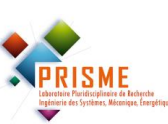Internship – last year of engineering school / Master (F/H)
6 months, starting around March-April 2025
Context and objectives
There is an increasing demand of renewable energies in the energetic mix, which is currently around 15 % in UE, and UE countries committed themselves to perform more ambitious energy decarbonization objectives (40 % of green energies according to GIEC & Paris agreements). The total installed power capacity in Europe need to reach 500 GW by 2030 to meet the European energy targets. This growth will require an increase of the installation of new wind turbines, but also the optimization of existing farms. Such optimization is industrially done using simplified models and reference tables performed in open-loop for the maximization of power production. It is estimated that closed loop estimation and control of wind farms can target up to 30 % power gain with respect to using all possible control inputs [Munters2018].
In short, the different wind turbines interact with the incoming flow and the control of the individual turbines impacts the full farm [Nygaard2020]. What is desired is to maximize the total electric power generated by the farm, but also to prevent potential damages and fatigue on the wind turbines. Besides, any change in the incoming wind speed and direction results in new farm wakes and to losses between the wind turbines. This is the case when gusts occur and result to a sudden change of the incoming flow conditions. This unsteadiness of the aerodynamic performance yields large fluctuations of the generated power and significant fatigue loads on wind turbines [Zhou2018] . In terms of control, these incoming gusts are considered as perturbations of the nominal performance of the wind farm. [Kanev2010].
The main objective of the internship is to study experimentally the behaviour of the wake under quick perturbations of the incoming flow. A wind turbine model will be considered in the S2 wind tunnel of the PRISME laboratory. The wind tunnel is equipped with standard fluid mechanics metrology (in particular pressure and hot-wire measurements), mounted in a displacement system for large-scale measurements. The inlet of the wind tunnel main section can be replaced with passive or active turbulence grids. The current internship will focus of the active grid for the generation of wind gusts with particular length and time scales, and the impact on the wind turbine wake.
Work environment of the internship
The person who will be recruited will join the research team Écoulements et Systèmes Aérodynamiques (ESA) of the PRISME laboratory. The intern will be part of a pluridisciplinary project of the PRISME laboratory, between the Aerodynamics and Automatic science teams. The internship will also be helped with an ongoing thesis on wind turbines wakes, and the means of the ANR Young Researcher SONATE. Eventually, the recruited intern will be part of the Aerodynamics team, a group of 5 permanent researchers and others PhD students and interns.
To achieve these objectives, work will be organized around the following points:
❖ State of the art review.
❖ Validation of the gusts generation using the active grid
❖ Study of the experimental wind turbine wake under a gust profile
❖ Parametric effect of the length and time scales of the gust on the wake
❖ Dissemination and exploitation of results.
Resources
This Master internship will benefit from an extremely favourable working environment in terms of resources and expertise, especially in wind turbines wakes [Aubrun2013, Fuentes-Noriega2022]. This study will take benefit of the coupling between experimental database available in the PRISME laboratory and advanced post-processing analysis codes existing in the team.
Bibliography
1. Munters W, Meyers J. Towards practical dynamic induction control of wind farms: Analysis of optimally controlled wind-farm boundary layers and sinusoidal induction control of first-row turbines. Wind Energy Science, 2018, 3:409–425.
2. Zhou, K., Cherukuru, N., Sun, X., & Calhoun, R. (2018). Wind gust detection and impact prediction for wind turbines. Remote Sensing, 10(4), 514
3. Nygaard, N. G., Steen, S. T., Poulsen, L., & Pedersen, J. G. (2020). Modelling cluster wakes and wind farm blockage. Journal of Physics: Conference Series, 1618(6), 062072.
4. Kanev, S., & van Engelen, T. (2010). Wind turbine extreme gust control. Wind Energy: An International Journal for Progress and Applications in Wind Power Conversion Technology, 13(1), 18-35.
5. Fortes-Plaza, A., Campagnolo, F., Wang, J., Wang, C., & Bottasso, C. (2018). A POD reduced-order model for wake steering control, Journal of Physics: Conference Series, 1037(3), 032014.
6. Aubrun, S., Loyer, S., Hancock, P. E. & Hayden, P. (2013). Wind turbine wake properties: Comparison between a non-rotating simplified wind turbine model and a rotating model. Journal of Wind Engineering and Industrial Aerodynamics, 120, 1-8.
7. Fuentes-Noriega, E., Raibaudo, C., Weber, R. & Mazellier, N. (2022). On the influence of a swirling motion on the wake of a porous disc: an experimental investigation. 25e Congrès Français de Mécanique, Nantes.
Expected skills
Engineering student BAC+5 or Master M2 student with strong knowledge of fluid mechanics.
Important skills in data processing softwares (Python, Matlab).
Strong capability of communication (speaking, writing).
How to apply
Send a curriculum vitae, a cover letter, a recommendation letter for references and a transcript (even partial) of grades for the last two years at Cédric Raibaudo (cedric.raibaudo@univ-orleans.fr) and Nicolas Mazellier (nicolas.mazellier@univ-orleans.fr) before January, 19th 2025
